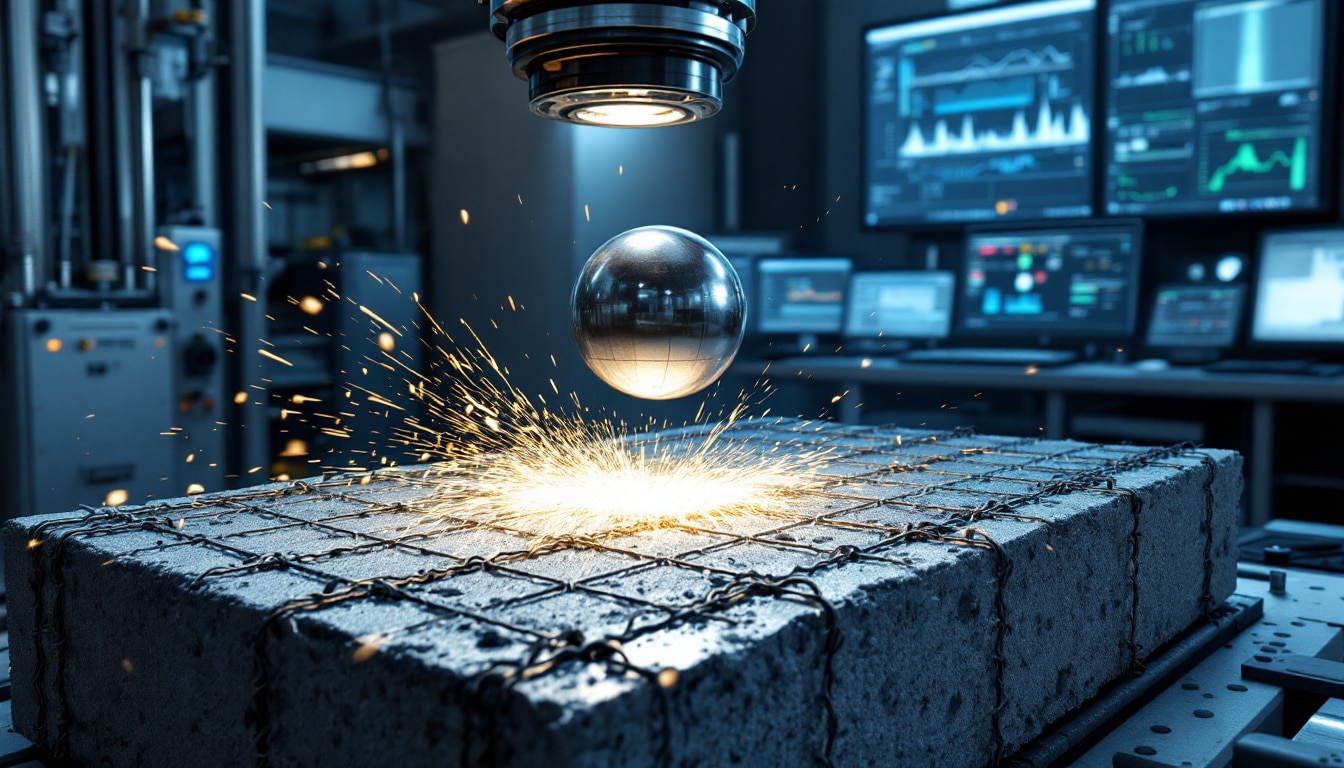Concrete embodies one of the most versatile construction materials, used in civil, military, and critical structures. Its dynamic behavior is strongly influenced by the effects of the strain rate. At high strain rates, concrete generally exhibits increased strength and stiffness.
The experimental study of the effects of strain rate on concrete is intrinsically linked to the choice of loading devices. For example, researchers such as Guo and Chen have used the Split Hopkinson Pressure Bar (SHPB) to apply high strain rates to samples. On the other hand, numerical simulations, such as those conducted by Zhou and Hao, explore the compressive behavior of concrete under such conditions. Meanwhile, attention has recently focused on the impact resistance of concrete structures, essential for both civil and military applications. Concrete, as a multiphase composite, exhibits complex mechanical behaviors, including tension-compression asymmetry and strain rate-dependent effects. Despite advances in experimental and numerical approaches, challenges remain, particularly regarding the variability of test conditions and simplifications in numerical models. This integration of experimental and analytical approaches allows for better prediction of penetration resistance and optimization of the design of protective concrete structures against rigid projectile impacts.
Composite materials, such as ultra-high performance concrete (UHPC), have been extensively studied for their increased resistance to high-velocity projectile impacts. Recent research has shown that adding steel fibers and specific aggregates significantly improves concrete’s ability to absorb energy and resist penetration. For example, Zhang and colleagues combined experimental and numerical methods to assess the penetration depth of hypersonic projectiles into concrete targets. Moreover, advanced numerical models, such as the concrete damage plasticity (CDP) model, provide a better understanding of the dynamical behavior of concrete structures under extreme loads.
Furthermore, parametric analyses have revealed the importance of variables such as the projectile mass, nose shape, and concrete compressive strength in determining penetration depth. Studies have shown that ogive-headed projectiles offer better penetration resistance compared to hemispherical or flat-tipped projectiles. Additionally, incorporating factors like dynamic strain rate into analytical models enhances the accuracy of impact resistance predictions. These advancements enable the development of more robust concrete structures that are better suited to modern protection requirements.
Recent developments in finite element tools have also reinforced the importance of numerical simulations in analyzing the behavior of concrete under impact. Studies such as those by Liu and Wang have demonstrated the effectiveness of numerical methods in assessing the performance of reinforced concrete slabs against rigid projectile loads. Simultaneously, analytical models based on cavity expansion theory offer simplified yet accurate solutions for estimating penetration depth, thus facilitating the predictive design of impact-resistant structures.
Table of Contents
ToggleIntroduction to the Resistance of Reinforced Concrete Slabs Against Rigid Projectiles
The penetration resistance of reinforced concrete slabs under the impact of rigid projectiles is a topic of crucial significance in modular construction and structural safety. Reinforced concrete slabs are widely used in critical infrastructures such as bunkers, levees, and nuclear power plants, where the ability to withstand violent impacts is essential. This study relies on a combination of analytical and finite element models to evaluate and enhance this resistance.
How Does Reinforced Concrete Respond to Rigid Projectile Impacts?
Reinforced concrete is recognized for its versatility and robustness, but its dynamic response to a rigid projectile impact depends on several factors. Among them, the strain rate plays a pivotal role. At high strain rates, reinforced concrete tends to increase in strength and stiffness, offering better protection against penetration. However, the complexity of the interactions between the components of concrete and the projectiles necessitates an in-depth understanding through experimental and simulation methods.
What is the Impact of Strain Rates on Concrete Behavior?
Strain rates significantly influence the mechanical behavior of concrete. At higher rates, concrete properties such as compressive strength and stiffness generally increase. This dynamic response is crucial for impact resistance, as it allows concrete to better absorb and dissipate the energy generated during projectile penetration. Studies, such as those conducted by Gunay et al. [4], have shown that using methods like the Split Hopkinson Pressure Bar (SHPB) enables the evaluation of these effects at very high strain rates, up to 1288 s⁻¹.
What are the Experimental Methods for Testing Impact Resistance?
Experimental methods play a crucial role in assessing the resistance of reinforced concrete slabs. Techniques such as the Split Hopkinson Pressure Bar (SHPB) and dynamic impact testing allow for simulating extreme conditions and measuring the response of concrete under impact. For example, researchers like Wu et al. [12] have analyzed the impact resistance of reinforced concrete targets by measuring the residual speeds of projectiles after collision. These methods validate numerical and analytical models by providing accurate data on the real behavior of materials.
How Do Finite Element Models Help Simulate Impacts?
Finite element (FE) models are powerful tools for simulating the resistance of reinforced concrete structures against rigid projectile impacts. By using advanced software, it is possible to create detailed representations of concrete slabs and simulate the dynamic interactions with projectiles. Zhou and Hao [5], for example, used macroscopic and mesoscopic models to explore the compressive behavior of concrete under high strain rates. These simulations allow for predicting penetration and optimizing the design of structures for better resistance.
What Are the Advantages of Analytical Models Based on Cavity Expansion Theory?
Analytical models based on cavity expansion theory provide a complementary approach to numerical simulations. These models simplify the problem by considering concrete as a compressible material and analyzing the distribution of radial stresses during impact. Forrestal and Tzou [42] extended the SCE theory to predict penetration depth, thereby providing quick and accurate estimates without needing complex simulations. These models are particularly useful for conducting preliminary analyses and guiding future research.
What Case Studies Illustrate the Application of Analytical and Finite Element Models?
Several case studies demonstrate the effectiveness of analytical and finite element models in evaluating projectile resistance. For instance, Liu et al. [23] numerically assessed the performance of reinforced concrete slabs enhanced with ultra-high performance concrete (UHPC) under high-speed impacts. Similarly, Rathod et al. [21] explored the influence of incidence angles on ballistic performance, revealing that higher angles improve energy absorption. These case studies show how an integrated approach allows for a better understanding and improvement of the resistance of reinforced concrete structures.
What Challenges Persist in Studying the Impact Resistance of Reinforced Concrete?
Despite significant advancements, several challenges remain in studying the impact resistance of reinforced concrete slabs. The variability of test conditions, such as types of projectiles, impact speeds, and target configurations, complicates the generalization of results. Additionally, simplifying assumptions in numerical models, such as material behavior laws and damage evolution equations, may not fully capture the complex behaviors of concrete under extreme loads. Ongoing research is needed to refine these models and improve their accuracy.
What Are the Future Prospects for Improving the Resistance of Reinforced Concrete Slabs?
Future prospects for improving the resistance of reinforced concrete slabs include the integration of new technologies and innovative materials. The use of steel fibers and hybrid composites can significantly enhance penetration resistance, as demonstrated by Feng et al. [22]. Furthermore, the application of advanced techniques such as 3D printing allows for creating structures optimized for better energy absorption. Additionally, the integration of circular economy practices in the construction process can not only enhance durability but also performance of reinforced concrete slabs.
Material Innovations for Better Resistance
Material innovations, such as the incorporation of carbon fibers and nanocomposites, offer significant improvements in penetration resistance. These reinforced materials allow for better dissipation of impact energy and reduce deformation in reinforced concrete slabs.
Optimization Through Advanced Simulation
Advancements in numerical simulations and artificial intelligence enable more precise modeling of the complex interactions between projectiles and concrete. Techniques such as deep learning can be used to refine predictions and proactively optimize structures.
How Can the Integration of Analytical Methods and Finite Elements Optimize Structural Design?
The integration of analytical methods and finite element approaches allows for a holistic design approach in reinforced concrete structures. By combining the accuracy of numerical simulations with the speed of analytical models, engineers can achieve more reliable and optimized results. This synergy facilitates the identification of structural weaknesses and offers innovative solutions for enhancing their resistance. Furthermore, cross-validation between methods ensures a better understanding of failure mechanisms and strengthens confidence in the obtained results.
Why is the Circular Economy Important in the Design of Reinforced Concrete Slabs?
The adoption of the circular economy in the design of reinforced concrete slabs contributes not only to environmental sustainability but also to performance optimization. By reusing recycled materials and integrating sustainable construction practices, it is possible to reduce costs and carbon footprint while enhancing the resistance of structures. Case studies show that the circular economy can create more effective and resilient concretes against impacts, while meeting contemporary ecological and economic requirements.
What Emerging Tools and Technologies Strengthen Penetration Resistance?
Emerging tools and technologies play a crucial role in improving the resistance of reinforced concrete slabs. 3D printing allows for manufacturing structures with optimized complex geometries to absorb impacts. Additionally, the use of predictive models based on artificial intelligence and machine learning is becoming essential for anticipating material behaviors under various loading conditions. These technologies facilitate the design of reinforced concrete slabs that are more resistant and adaptable to varied impact scenarios.
How Do Pilot Projects Contribute to Advancing Research?
The implementation of pilot projects offers a unique opportunity to test and validate new approaches and technologies in real conditions. These projects allow for collecting valuable data and refining existing models while demonstrating the feasibility of innovations in the field. By collaborating with key industry players, pilot projects encourage the rapid adoption of best practices and facilitate the transition to more robust and efficient solutions.
What Are the Main Findings of the Study on the Penetration Resistance of Reinforced Concrete Slabs?
The in-depth study on the penetration resistance of reinforced concrete slabs reveals several key findings. First, slabs reinforced with advanced materials such as UHPC show a notable improvement in their capacity to withstand impacts, particularly due to the addition of steel fibers that strengthen the concrete matrix. Second, finite element simulations have enabled accurate predictions of failure areas and optimized the arrangement of reinforcements for better energy absorption. Finally, analytical models based on cavity expansion theory have provided reliable estimates of penetration depth, validated by experimental data. These findings highlight the importance of a multi-method approach to design more resistant and durable reinforced concrete slabs.
How Does the Integration of Fibers Influence the Resistance of Reinforced Concrete Slabs?
The integration of fibers into reinforced concrete, such as steel or carbon fibers, significantly enhances the penetration resistance of slabs. These fibers strengthen the concrete matrix, thus increasing its capacity to dissipate impact energy and prevent cracking and fragmentation under load. Feng et al. [22] demonstrated that steel fibers increase penetration resistance, although this resistance may decrease after several successive impacts. The addition of fibers also improves the ductility of the concrete, allowing it to better absorb shocks and return to its initial state after an impact.
What Factors Influence the Penetration Depth of Projectiles?
Several factors influence the penetration depth of projectiles into reinforced concrete slabs. Among these, the projectile mass, its nose shape (ogive, hemispherical, or flat), and the impact speed are critical. For example, projectiles with an ogive shape tend to penetrate deeper due to their aerodynamics, while flat projectiles better distribute energy over a larger surface, thereby reducing penetration depth. Additionally, increasing the impact speed generally increases penetration depth, but it can also lead to non-linear behaviors of the concrete, complicating predictions.
How Do Numerical Simulations Bridge the Gap Between Theory and Practice?
Numerical simulations play a crucial role in bridging the gap between theoretical models and practical applications. By allowing a detailed and parametric analysis of the behavior of reinforced concrete slabs under impact, they provide valuable insights that are not easily obtained by experimental methods alone. For instance, the work of Peng et al. [28] on penetration simulations has enabled the development of accurate predictive models for penetration depth, validated by experimental tests. This integration facilitates the optimization of structural designs and the development of more robust safety standards.
What is the Importance of Experimental Validation in Projectile Resistance Studies?
Experimental validation is essential to ensure the reliability of the analytical and numerical models used in projectile resistance studies. Without validation, the predictions of simulations may not accurately reflect the real behavior of materials. Studies such as those conducted by Hanchak et al. [17] and Sun et al. [18] have shown that rigorous experimental testing is necessary to calibrate and adjust the models, thereby ensuring the accuracy and relevance of results. This validation step is crucial for the trust and adoption of new techniques and materials in the construction industry.
How Do Pilot Projects Influence Future Research and Developments?
Pilot projects play a decisive role in shaping research and developments related to the penetration resistance of reinforced concrete slabs. By testing hypotheses and innovations in real conditions, these projects help identify the strengths and weaknesses of new approaches before widespread adoption. They also provide essential empirical data to refine theoretical and numerical models, ensuring that future research is well-aligned with field needs and realities. Collaborations among researchers, engineers, and construction companies within pilot projects also encourage knowledge transfer and continuous innovation in the field.















